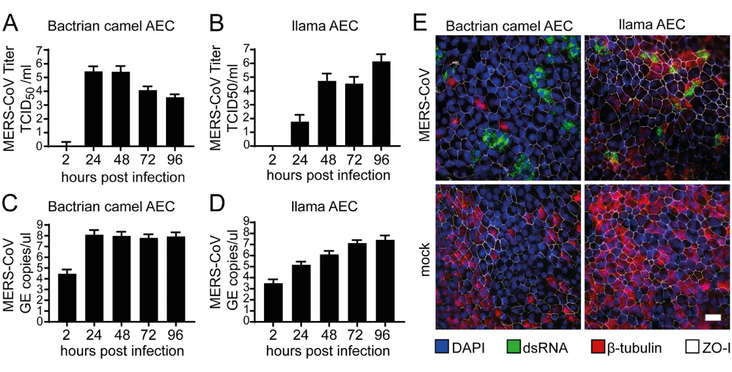The Dijkman and Thiel labs with collaborators established an epithelial cell culture model to study MERS-CoV. As the natural host of the zoonotic MERS Coronavirus are camelids, they suded cells from camels and lamas to establish their model. They could demonstrate that in this model the replication of the virus could be inhibited by type 1 as well as type 3 interferons. The corresponding article " Establishment of well-differentiated camelid airway cultures to study Middle East respiratory syndrome coronavirus" has been published in Scientific Reports.
Abstract
In 2012, Middle East respiratory syndrome coronavirus (MERS-CoV) emerged in Saudi Arabia and was mostly associated with severe respiratory illness in humans. Dromedary camels are the zoonotic reservoir for MERS-CoV. To investigate the biology of MERS-CoV in camelids, we developed a well-differentiated airway epithelial cell (AEC) culture model for Llama glama and Camelus bactrianus. Histological characterization revealed progressive epithelial cellular differentiation with well-resemblance to autologous ex vivo tissues. We demonstrate that MERS-CoV displays a divergent cell tropism and replication kinetics profile in both AEC models. Furthermore, we observed that in the camelid AEC models MERS-CoV replication can be inhibited by both type I and III interferons (IFNs). In conclusion, we successfully established camelid AEC cultures that recapitulate the in vivo airway epithelium and reflect MERS-CoV infection in vivo. In combination with human AEC cultures, this system allows detailed characterization of the molecular basis of MERS-CoV cross-species transmission in respiratory epithelium.
Read the Publication in Scientific Reports (Open Access)
Abstract, figure and tilte from Gultom, Kratzel et al. (2022) Scientific Reports published under a CC BY 4.0 license.
